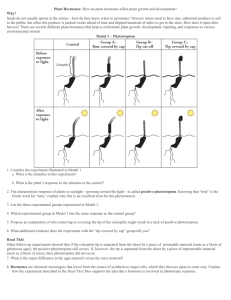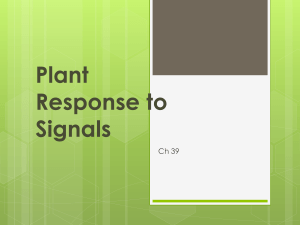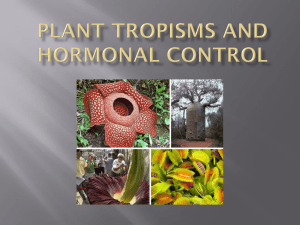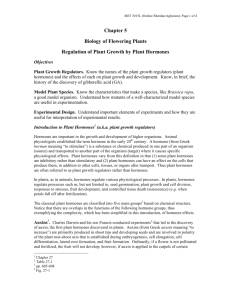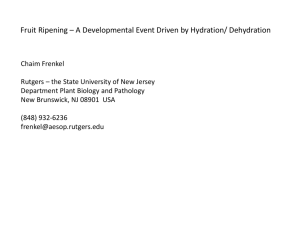Plant Hormones: Growth & Development Worksheet
advertisement
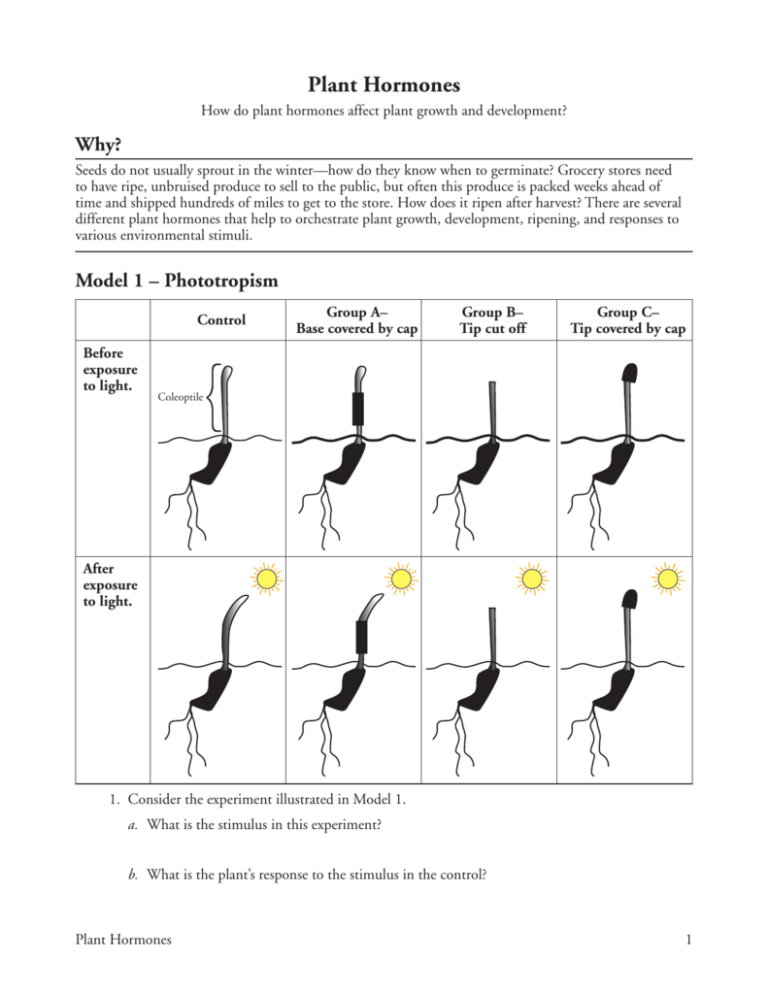
Plant Hormones How do plant hormones affect plant growth and development? Why? Seeds do not usually sprout in the winter—how do they know when to germinate? Grocery stores need to have ripe, unbruised produce to sell to the public, but often this produce is packed weeks ahead of time and shipped hundreds of miles to get to the store. How does it ripen after harvest? There are several different plant hormones that help to orchestrate plant growth, development, ripening, and responses to various environmental stimuli. Model 1 – Phototropism Control Before exposure to light. Group A– Base covered by cap Group B– Tip cut off Group C– Tip covered by cap Coleoptile After exposure to light. 1. Consider the experiment illustrated in Model 1. a. What is the stimulus in this experiment? b. What is the plant’s response to the stimulus in the control? Plant Hormones 1 2. The characteristic response of plants to sunlight—growing toward the light—is called positive phototropism. Knowing that “trop” is the Greek word for “turn,” explain why this is an excellent term for this phenomenon. 3. List the three experimental groups represented in Model 1. 4. Which experimental group in Model 1 has the same response as the control group? 5. Propose an explanation of why removing or covering the tip of the coleoptile might result in a lack of positive phototropism. 6. What additional evidence does the experiment with the “tip covered by cap” group tell you? Read This! Other follow-up experiments showed that if the coleoptile tip is separated from the shoot by a piece of permeable material (such as a block of gelatinous agar), the positive phototropism still occurs. If, however, the tip is separated from the shoot by a piece of impermeable material (such as a block of mica), then phototropism did not occur. 7. What is the major difference in the agar material versus the mica material? 8. Hormones are chemical messengers that travel from the source of synthesis to target cells, which they then act upon in some way. Explain how the experiment described in the Read This! box supports the idea that a hormone is involved in phototropic response. 9. The hormone from the coleoptile tip was later identified and named “auxin.” Auxins are a group of plant hormones that have many actions on plant growth and development, but the main effect is elongation of the cells in stems. If these hormones are stimulated by sunlight, discuss with your group how the auxins might cause the coleoptile to bend towards the light. 2 POGIL™ Activities for AP* Biology 10. Design an experiment using a seedling and a block of agar soaked with auxins that might confirm the effect of this hormone on the elongation of the coleoptile. (Hint: Remember that the auxins are permeable to the agar material.) 11. In the space below, sketch the predicted results of your group’s experiment. 12. The phototrophic response to sunlight is a mechanism that evolved over millions of years. What advantage to the plant is there from this response to sunlight? Model 2 – Seed Germination Variable Untreated Coated with gibberellins Coated with abscisic acid (ABA) Seed before After Plant Hormones 3 13. Consider the experiment illustrated in Model 2. a. What are the independent variables in this experiment? b. Which seed is used as a control? 14. Refer to Model 2. a. What is the effect of gibberellins? b. What is the effect of the abscisic acid (ABA) on the plant? 15. Gibberellins and ABA are both plant hormones. Based on the results of this experiment, write a grammatically correct sentence that summarizes the different effects of these two hormones on seed germination. 16. Gibberellins are found in the plant embryo inside the seed. This plant hormone acts to stimulate the synthesis of digestive enzymes that release nutrients stored in the seed. Why is this action necessary for successful seed germination? 17. ABA plays a major role in seed dormancy. Seeds stay dormant for a number of reasons, such as waiting for proper water levels or warmth before germinating. Why would it be necessary for seeds to have some way to inactivate ABA when the conditions are right for germination? 18. With your group, propose a stimulus that might activate the gibberellins and inactivate the ABA in order to control the proper germination of seeds. 19. ABA is water-soluble. Gibberellins are not. Consider standard practice when planting seeds and propose an explanation for why you would water an area where you have just planted seeds. 20. Propose an explanation for why desert plants might be especially dependent upon ABA. 4 POGIL™ Activities for AP* Biology Read This! Unripened fruits are hard and tart. The plants evolved in this way because the undesirable taste of the fruit protected the underdeveloped seeds, so that they would not be dispersed before they were ready. Ripening is a process that sweetens and softens the fruit to make it more attractive to animals who will eat the fruit and disperse the seeds. A plant hormone, ethylene, leads to the ripening of many fruits. The enzyme polygalacturonase (PG) acts to soften fruit by the enzymatic action on the cell wall and works with ethylene in the ripening process. 21. Refer to the Read This! box above. List two chemical substances that plants utilize to ripen fruit. 22. Consider the process of ripening as described in the Read This! box. a. What is the role of the cell wall in plant structure? b. Why does the action of PG on the cell wall make fruit softer? 23. Why would the ripening process be advantageous to the plant? 24. A common kitchen trick to ripening fruit is to place unripe fruit near a piece of ripe fruit on the counter. This greatly increases the rate of ripening for the unripe fruit. How does this observation provide evidence that ethylene is a gas? 25. In a rare biological example of positive feedback, an increase in ethylene production triggers more ethylene production. Explain how this effect, and the fact that ethylene is a gas, could help to coordinate the timing of the ripening process on a plant. 26. It is imperative that grocery stores have ripe fruit at the store for consumers to buy, but it is easier to transport produce in an unripened state. Explain how the commercial use of ethylene might help to solve this dilemma. Plant Hormones 5 Extension Questions Model 3 – Genetically Modified Food Normal process With inserted gene DNA – Gene for polygalacturonase DNA – Gene for polygalacturonase DNA – Inserted Flavr Savr gene ATCGGATCGAACGACTACTACTACTG ATCGGATCGAACGACTACTACTACTG CAGTAGTAGTAGTCGTTCG A TCCGA T TAGCCTAGCT TGCTGATGATGATGAC TAGCCTAGCT TGCTGATGATGATGAC G T C A T C A T C A T C A G CA A GC T A GGC T A Transcribed mRNA Transcribed Transcribed mRNA UAGCCUAGCUUGCUGAUGAUGAUGAC UAGCCUAGCUUGCUGAUGAUGAUGAC GUCAUCAUCAUCAGCAAGCUAGGCUA (Flips over) Translated AUCGGAUCGAACGACUACUACUACUG UAGCCUAGCUUGCUGAUGAUGAUGAC Protein Enzyme activity Polygalacturonase softens fruit. Fruit does not soften or ripen. 27. Consider the normal activation of the gene for polygalacturonase in Model 3. What is the end result of the activation of this gene? 28. When the Flavr Savr gene is present in the fruit it is transcribed into a second piece of mRNA. What is the interaction of the Flavr Savr mRNA transcript and the polygalacturonase mRNA transcript? 29. How does the presence of the Flavr Savr gene prevent the fruit from softening? 30. Currently almost half of the produce harvested in the United States is ruined by spoilage! If the Flavr Savr gene was used to reduce spoilage, how might the grocers ripen the fruit in a controlled manner once it reaches the store? 6POGIL™ Activities for AP* Biology
